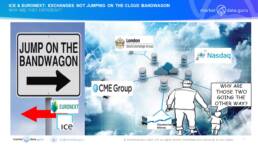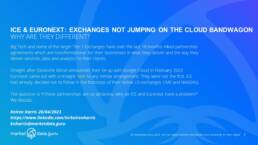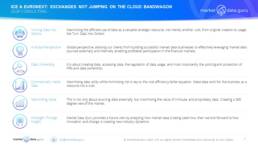

RELATIONSHIPS NOT PARTNERSHIPS
First, we have to understand what we mean by The Cloud Bandwagon. In MDGs 2023 annual review of the Tier 1 Exchange’s businesses and information services a main plank was the growing partnerships between Big Tech’s Cloud providers and the largest exchanges, CME/Google, DBAG/Google, LSEG/Microsoft, and NASDAQ/AWS which go far beyond the basic provision of Cloud based infrastructure. These are deals which move data processing into proprietary Cloud environments, everything from trading to risk to analytics to, well, anything. What these exchanges have in common, plus S&P Global/AWS are:
1.Proprietary Data. Wide range of on venue data, though the straight price data can be sourced indirectly and relatively cheaply from multiple sources. While an attraction this is not the main driver
2.Value Added Data. A wide range of value added unique data that is core to trading and analytics, especially indices (and for S&P Credit Ratings as well)
3.Multiple Trading Venues. Trading across several asset classes, equities, fixed income, commodities, foreign exchange, even realty. One exchange can meet a substantial percentage of any financial institution’s investment needs for trading and clearing under one broad roof. A NASDAQ objective
4.Decision Tools & Analytics. Importantly they offer a range of decision making tools and analytics which require data processing
The last two points are very attractive to Big Tech because the exchanges can drive two way data delivery and processing into their Clouds on a global scale. At the same time the Exchanges hope their Cloud providers will open the door to a larger client universe.
It is therefore intriguing as to why both ICE and Euronext are not getting onto the Cloud bandwagon and being quite vocal about it.
ICE and Euronext are certainly not avoiding the Cloud, both are working with Big Tech as part of their Information strategies, AWS even publishes a case study of their work with Euronext (here).
The question is ‘If these partnerships are so attractive, why are ICE and Euronext wary?
DOES ICE & EURONEXT MEET THE 4 POINT CRITERA?
If the 4 points highlighted above form the basis of partnerships with Big Tech, would the Cloud Providers be interested?
Proprietary Data. ICE and Euronext both have a wide range of own brand data, with ICE’s US and UK venues traded on a global basis. Euronext is relatively Eurocentric, but Europe is easily a large enough market
Value Added Data. ICE definitely meets the criteria, and even has its own market data vendor, strong bond market coverage with a leading presence in evaluated pricing, plus building a realty based business as well. Euronext is more limited highlighted by its index business which revolves around its European suite of stock exchanges.
Multiple Trading Venues. ICE offers global trading to global investors whereas Euronext presence is centred around European equities with small venues in commodities and ultra competitive foreign exchange
Decision Tools & Analytics. Again, an area where ICE is a major player, one which fits well with its range of trading venues and its business unit is structured to serve. This is a segment Euronext has not really had a great deal of interest though post trade services could be leveraged.
Overall ICE would be a coup for a Cloud Provider whereas Euronext is probably more a ‘nice to have’.
WHY ICE & EURONEXT HAVE NOT SIGNED UP
It is probable that all the reasons why ICE and Euronext have yet to enter an agreement are not public, and the most obvious one is Big Tech has not put a deal on the table attractive enough.
However if their peer exchanges have all jumped on the bandwagon what holds ICE and Euronext back? Statements by senior executives have focused on three prime reasons which have been most revealing:
Control & Security. According to one ICE executive . “We really want to control that technology, and we actually think we do a very good job of that. I can’t even imagine the thought of outsourcing that critical infrastructure”.
Control & Politics. Stéphane Boujnah’s CEO of Euronext’s comment is illuminating “When it comes to strategic applications such as real-time data and operations of the market, we do not want them to be stored and operated by the data centres of companies which have decision-making centres outside the EU, and physical infrastructure outside the EU“. Given the sensitivities this makes sense, though does highlight the state of technology companies in the EU.
Regulatory. Euronext builds on the political reason by stating that there are a number of regulatory concerns that are likely to be raised which need to be addressed before deals are consummated. Market Data Guru definitely agrees with this
None of these reasons directly relate to the business making money, the stated concerns are all about control over dollar generating critical services. The political side is not a factor for US exchanges entering into deals with American companies, probably was not a major factor for LSEG, but must have been debated within Euronext’s fellow EU exchange, Deutsche Börse. So why is DBAG okay with a deal but Euronext is not?
While the big exchanges see merit in a Big Tech partnership, not a mere redistribution agreement, In many ways the reasons why an Exchange is not entering into a partnership with Big Tech should be of more interest to other exchanges, data sources, and trading venues especially if the reason is a poor deal, and why?
READ MORE
https://www.risk.net/risk-management/7956258/ice-exec-rejects-cloud-for-critical-infrastructure
www.brecorder.com/news/40234545/euronext-has-no-plans-to-copy-rivals-with-cloud-computing-deal
Keiren Harris 20 April 2023
For our information on our consulting services please visit www.marketdata.guru/data-compliance
To contact us knharris@marketdata.guru
Please contact info@marketdata.guru for a pdf copy of the article


